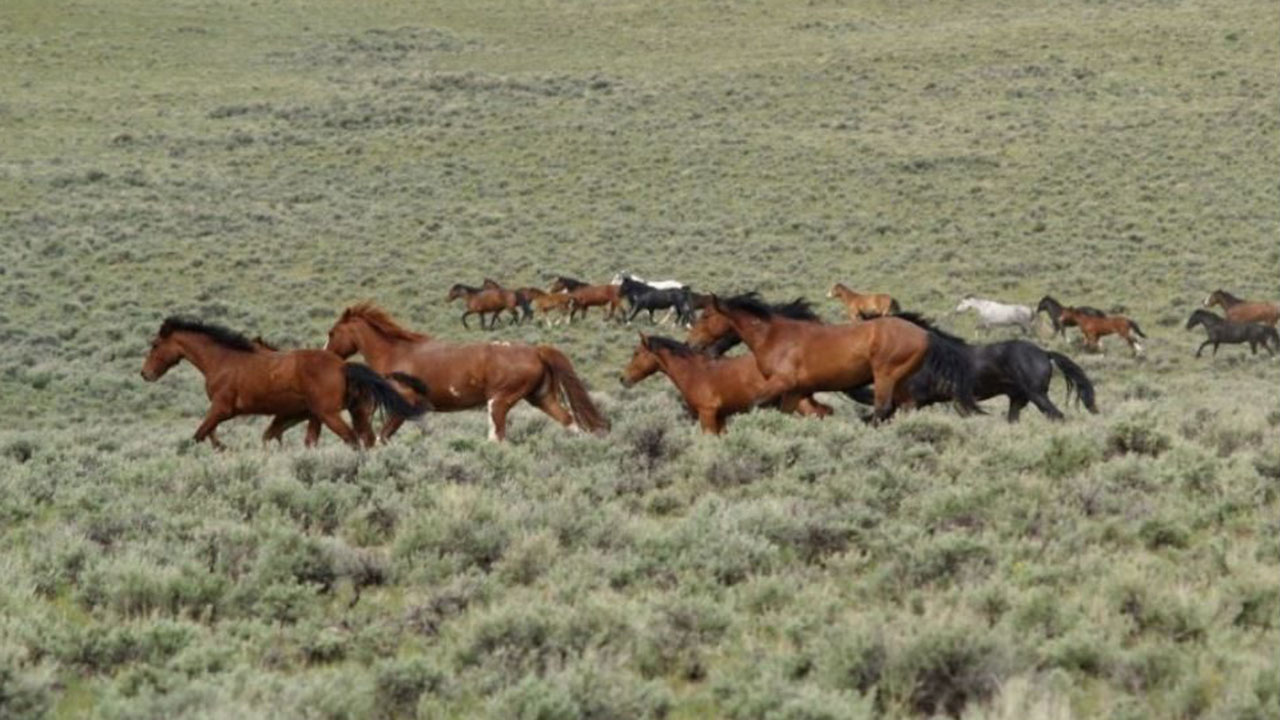Program trains wild horses for use in Wyoming forest

JACKSON, Wyo. (AP) - Some 95,114 wild horses and burros roam free throughout the United States, according to a March 1 count by the federal Bureau of Land Management.
The Wild Free-Roaming Horses and Burros Act of 1971 protects the mustangs, describing them as "an integral part of the natural system of the public lands." But wildlife biologists recommend a maximum of 26,770 equids on available public land - in Wyoming alone, the population is more than 4,900 horses over the state's goal - and ranchers say the overwhelming excess robs rangeland from their cattle.
Wildfire, wolves, grizzly bears: The Greater Yellowstone has no shortage of controversial management issues to tackle. But while the fight over wild mustangs on the open range has over the decades raged quieter, raged it has, and it continues to, throughout the western United States without a clear resolution.
But a program on the Bridger-Teton National Forest has at least a part of the solution, the Jackson Hole News & Guide reported.
Wild horses have no natural predators, so their numbers continue to grow. Between 2019 and 2020 alone, their population rose by 7,024 individuals, leaving the already tremendously overworked range to shoulder a hungry growing burden.
The BLM stepped up by rounding up horses off the open range and putting them up for adoption or shipping them a to contractor's ranch to be placed in fenced pasture for the rest of their lives. The agency also practices sterilization in an attempt to slow population growth. Others are used in exhibitions that highlight the abilities of trainers, and then are auctioned off.
But all of those solutions come with an expensive aftertaste. That's where the Blackrock Ranger District of the Bridger-Teton National Forest comes in, headed up most directly by Jack Hatch, stock manager for the district since the program's creation in 1989.
The brainchild of Brian Stout, former supervisor for the Bridger-Teton, the Blackrock program grew out of budgetary disapproval and a terrific impression by Wyoming Honor Farm, a Wyoming corrections facility in Riverton, that gives inmates the chance to train the wild horses.
The Wyoming Honor Farm proved well suited to the job, and Stout was able to move the Forest Service away from expensive purebreds and onto a hardier, more readily available steed.
Once Stout discovered Hatch in Montana, laid up with a broken neck, the program was set to succeed.
"Jack, to me, is probably one of the closest things to a horse whisperer of anybody that I've ever been around," Stout said.
Hatch lives up to the praise. Mu stangs, prone to a bad reputation and frequently treated like the redheaded stepchild, flourish in his program. He personally picks them from holding facilities, and has gone as far as Oregon to add to his string. He also trains for other forest districts, so he'll sometimes pick stock for them, too.
"They're as good as whatever you can put into 'em," Hatch said. "They've got better feet, better bone, they don't seem to colic like quarterhorses do. You can rope off of 'em, you can crack a whip off of 'em, you can do everything off of them."
The mustangs are used as mounts and pack animals for Forest Service rangers, and also are used to lug pesticides into hard-to-access areas to keep invasive plants at bay.
But there are plenty of expenses to keep the horses healthy, including shoeing, dental care, veterinary costs and feed. Hatch works hard to keep the program running on a slim budget that shifts with Forest Service employee changes.
Typically, Hatch takes on 40 to 50 head of horses and mules. This year, he has been tasked with cutting a few from the program. Some go directly to private homes, but typically, and as with most government property, they go to auction.
Despite financial shortcomings, Hatch's care and training of the horses remains above average.
"It's one thing to get hurt in town, in an arena, five minutes from a hospital," Hatch said. "But when you're 30 miles in the backcountry, (help) can't get to you."
That's why he takes his time to train each horse from nose to tail, he said.
"A mustang," he said, "if you train every piece of his body - I call that engaging - pretty soon he's listening to everything you're asking. And that's what takes the bad out of the horse."
Stout's marching orders were to make the horses successful and the humans successful.
"So I've kept that, I've never backed off," Hatch said.
He said the Forest Service rangers gain riding skills that can keep them safe, even when they can't immediately see the purpos e of the maneuvers he teaches.
There are eight such maneuvers Hatch would like each of his students to know, including a side pass, counter arcing, rollbacks, a stop and lead changes.
"It's hard to train people," Hatch said. "It's easy to train horses."
His 30 years of experience have made an indelible impression on man and animal alike. For the horses, their trajectory is forever changed - they have a purpose and a safe landing. For the humans, the result is much the same. Stout recalled several stories about the program from his 10 years as forest supervisor, including one about a 19-year-old boy who felt that training mustangs with Hatch was the first thing he'd ever been successful at.
"It's a horse program," said Stout, "and it's a success because it's working and working well. Plus it provides a meaningful home for the animals that are very well taken care of and in return perform the services they give."
But, be added, "It's also a people program in many, many ways."






